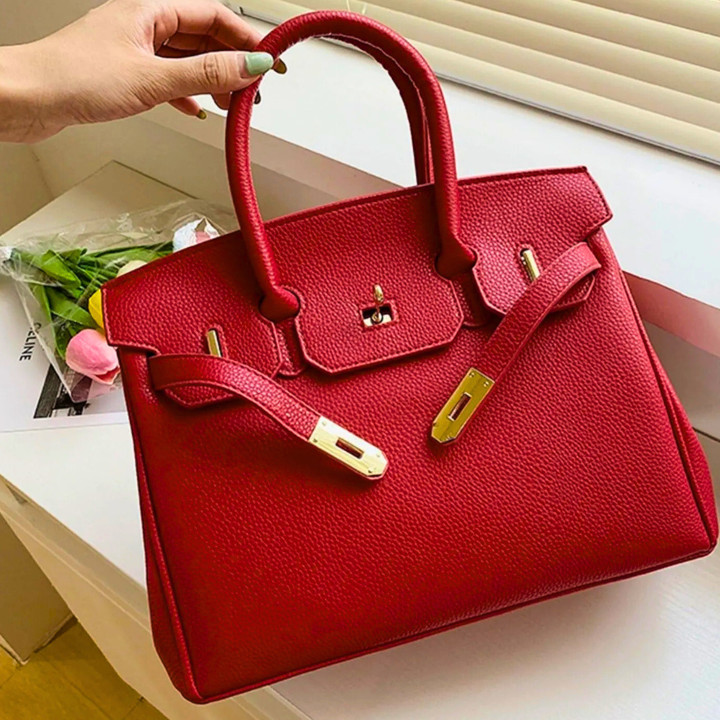In a world where high-end fashion often epitomises exclusivity, the arrival of the ‘Wirkin’ – a Birkin-inspired bag available for just USD$78 at Walmart – has sent shockwaves through the luxury market. Yes, you read that correctly: USD$78 for a bag that bears a striking resemblance to the iconic Hermès Birkin, renowned for its astronomical price tag, often reaching tens of thousands of dollars. Within days, social media platforms were ablaze with unboxing videos, glowing reviews, and countless memes proclaiming it the ‘Birkin for the working class’.
With a lock, top handle, and unmistakably Birkin-inspired silhouette, this bag has captured the attention of everyone – from budget-conscious fashionistas to those intentionally steering clear of luxury brands. Available in a variety of vibrant colours, including green, orange, and blue, this leather-look accessory delivers the allure of high-end style at just a fraction of the cost. But how did we get here? How has a USD$78 bag turned into a viral sensation? And, perhaps more intriguingly, what does its popularity reveal about today’s shifting consumer attitudes toward luxury?
Read More: Friday Club. Insider – Pashmkaar’s Tariq Dar Preserves Kashmiri Shawl Artistry

Why Consumers Are Seeking Alternatives
The rise of the ‘Wirkin’ can be attributed to the frustrations felt by many luxury consumers. The iconic Birkin bag, originally designed for actress Jane Birkin in the 1980s, has long served as a symbol of wealth. Its allure stems not merely from its exquisite craftsmanship, but also from its notorious inaccessibility. Owning a Birkin transcends a simple purchase; it signifies entry into a select circle, a privilege often requiring years of cultivating relationships with sales associates, substantial spending within the Hermès ecosystem, and enduring an extended waitlist. This inherent exclusivity, while frustrating for many, is precisely what fuels its desirability.
However, the equation shifts dramatically when the once unattainable becomes surprisingly accessible, albeit in a different form. While some may disdain the notion of settling for a replica, others perceive it as a democratised version of the coveted status symbol. With the luxury market grappling with escalating prices, particularly in the wake of the pandemic, consumers are increasingly questioning the value proposition of investing thousands in a luxury bag, especially when well-crafted alternatives offer comparable quality at a fraction of the cost. In this sense, the ‘Wirkin’ effectively taps into a growing consumer discontent with traditional luxury pricing.
Is The ‘Wirkin’ A Wake-Up Call For Luxury Brands?
Let’s be clear: the Wirkin is far from the first – or the last – dupe to infiltrate the market. From Lululemon leggings to Dyson vacuums, no luxury brand is immune to the rise of high-quality replicas. But what distinguishes the Wirkin is its immediate and resounding success, achieved despite – or perhaps because of – its availability on the mainstream retail platform, Walmart. The allure of exclusivity, once a primary driver of luxury consumption, is gradually being overshadowed by the accessibility of quality. Consumers are increasingly discerning, focusing on what the product symbolises – style, status, and perceived value. If a high-quality dupe can effectively deliver these attributes, why wouldn’t consumers embrace it?
But the big question remains: can luxury brands maintain their dominance in an era of accessible alternatives? According to experts, the true ultra-luxury market won’t be significantly affected by dupes in the short run. After all, there will always be those willing to shell out for the real thing. But the Wirkin’s success, along with the growing demand for more accessible alternatives, may signal a shift in how luxury brands need to evolve in the coming years.

Who’s Coming Out On Top?
The real question is not whether dupes will continue to flood the market, but rather how luxury houses can successfully adapt to a consumer base increasingly willing to embrace stylish products at more accessible price points. The ‘Wirkin’ may not be the final chapter in the saga of luxury dupes, but it undoubtedly represents the most prominent case to date. Whether or not Hermès feels the heat remains to be seen, but one thing is for sure: the days of blind brand loyalty may soon be over. If the market for luxury continues to evolve in this direction, it’s the brands that can find a balance between exclusivity and accessibility that will ultimately win.

Catherine Pun
A Hong Kong native with Filipino-Chinese roots, Catherine infuses every part of her life with zest, whether she’s belting out karaoke tunes or exploring off-the-beaten-path destinations. Her downtime often includes unwinding with Netflix and indulging in a 10-step skincare routine. As the Editorial Director of Friday Club., Catherine brings her wealth of experience from major publishing houses, where she refined her craft and even authored a book. Her sharp editorial insight makes her a dynamic force, always on the lookout for the next compelling narrative.




